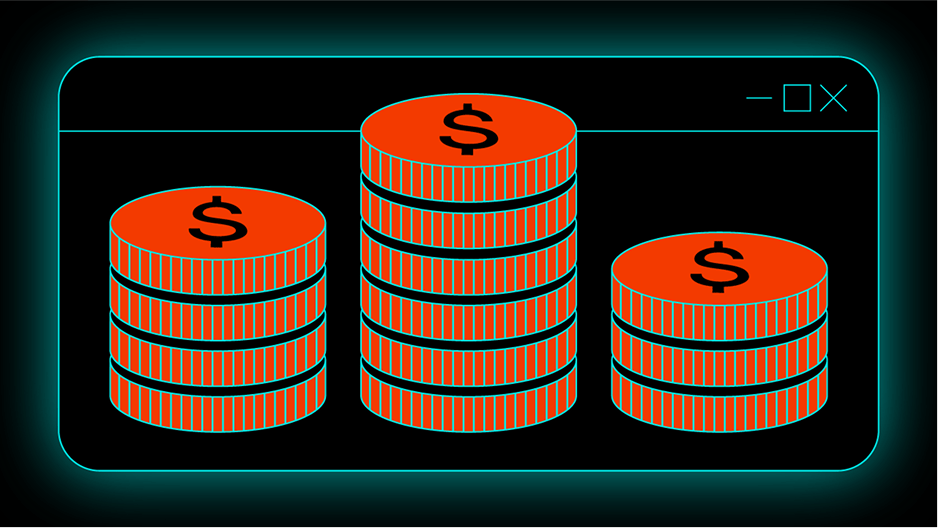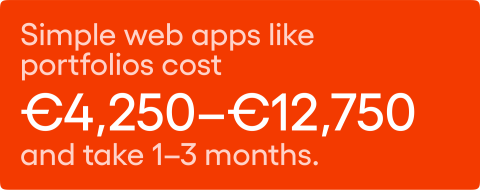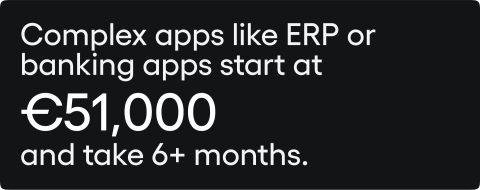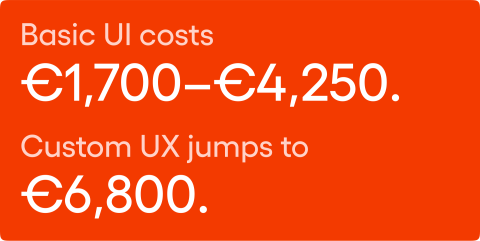Web app development costs: A detailed guide for 2025


In 2025, the web development market is set to grow rapidly, valued at €68.71 billion ($74.69 billion) and forecast to reach €95.96 billion ($104.31 billion) by 2030, with a steady 6.91% annual growth rate. Meanwhile, the progressive web app market is expected to jump from €1.79 billion ($1.95 billion) in 2025 to €20.30 billion ($22.07 billion) by 2034, at a striking 31% growth rate. Since businesses see great potential for returns on their investment, we will break down web app development costs, highlighting proven ways to reduce the final expenses.
Table of contents
Web application development costs by complexity
Each web application has its own purpose, and its complexity determines the budget required. A straightforward site demands far less than a platform rich with features. Here is a detailed examination of how costs appear in 2025.
Simple web applications
Envision a personal portfolio or a news page—neat, simple, and direct. These represent entry-level web applications suitable for exploring the digital world or displaying a personal project. Costs typically range between €4,250 and €12,750 (5,000 to 15,000 USD).
Why are these relatively inexpensive? They focus on essentials: a user interface that is easy to use, minimal content, and a basic backend to ensure operation. There are no elaborate additions—just what is necessary to exist online. The development process is completed quickly, within 1 to 3 months, based on the team’s speed and the project’s size.
For example, a blog might include an area for posts and a basic database, nothing beyond that. This makes it an excellent starting point for small businesses or individuals aiming to maintain a modest web app cost.
Is that still too much? There are some options of low code and no code that may be an attractive choice; however, low code and no code has its own challenges, like limited customisation, potential scalability issues, and reliance on third-party platforms, so you can think it over if you’re not afraid of navigating those hurdles.

Medium complexity web applications
Now consider an e-commerce store or a B2B SaaS platform—applications with greater substance, with costs varying from €12,750 to €51,000 (15,000 to 60,000 USD). The timeline extends to 4 months as the tasks increase.
What causes this higher expense? Features with sophistication. An e-commerce application requires payment gateways to complete transactions, inventory management to monitor stock, user authentication to ensure safety, and a need for integrations with ERP, CRM systems, etc.—elements absent in simpler designs.
A project management tool may include interactive components such as task boards or team notifications, combining frontend development for appearance with backend development for data handling. This represents an advancement—a more robust web application requiring a larger web development budget yet offering greater impact.

Complex web applications
Finally, there are the major players: ERP systems, healthcare applications, and IoT platforms—applications that operate on a grand scale. These begin at €51,000 (60,000 USD) and may rise from €170,000 or €212,500 (200,000 to 250,000 USD) — or even more. Development time extends up to 6 months, often exceeding this for the most ambitious projects.
These are sophisticated creations. A banking application might manage real-time account transactions, integrate with global payment systems through third-party APIs, and ensure compliance with strict financial regulations and security standards.
An ERP system could coordinate payroll, supply chains, and additional operations, relying on intricate features and tailored solutions. The development team — software developers, a project manager, and designers—works extensively to achieve this. The cost to develop reflects the scale of ambition, and for businesses, it constitutes a substantial investment capable of transforming their operations.

Factors influencing web application development costs
Complexity establishes the base, but other aspects adjust the final price. Let us explore the primary influences, ranging from features to distant teams.
Scope of work and features
Fundamentally, the cost of a web application depends on its functions. Basic elements—such as user profiles or a login page—maintain affordability, fitting comfortably within €4,250 to €12,750 (5,000 to 15,000 USD) for a simple project.
However, introducing advanced features increases the expense. Real-time processing for a chat application or AI-driven insights for personalised suggestions can elevate costs to €51,000 (60,000 USD) or higher.
Third-party integrations add further complexity. Connecting to payment systems or social media APIs requires additional effort, typically increasing costs by €850 to €4,250 (1,000 to 5,000 USD) per link.
The wider your ambitions, the more challenging the development process becomes. Businesses must decide whether to focus on essential features or invest in extras that impress their target audience—a matter of setting priorities.
UI/UX design requirements
The appearance of a web application holds significance. A basic user interface, created using pre-existing templates, costs €1,700 to €4,250 (2,000 to 5,000 USD) — swift, functional, and adequate for a minimum viable product. However, a custom UI/UX featuring unique branding and fluid animations rises to €5,100 to €6,800 (6,000 to 8,000 USD).

Creating wireframes and prototypes adds €850 to €3,400 (1,000 to 4,000 USD). Why allocate funds here? A refined design attracts users, particularly on mobile devices where progressive web applications excel. Reducing effort may result in a clumsy experience; dedicating resources ensures your application stands out among competitors.
Development approach
The method chosen to construct your application influences the cost. Custom web app development, designed entirely from the beginning, starts at €10,200 to €21,250 (12,000 to 25,000 USD) and increases with greater goals. Template-based web applications, relying on prepared frameworks, range from €4,250 to €6,800 (5,000 to 8,000 USD). No-code or low-code platforms offer a simpler option at €425 to €4,250 (500 to 5,000 USD).
Each approach offers distinct advantages. Custom projects adapt well to complex web applications but require time. Templates complete quickly for a simple web application, though they lack distinctiveness. No-code suits those with limited technical knowledge, yet struggles with expansion. Your selection shapes both the expense and the final result.
Development team location
The location of your developers significantly impacts the cost. In thriving technology hubs like the United States or Western Europe, hourly rates range between €96 and €167 ($100–$175), reflecting the high salaries driven by living expenses and proximity to major markets.
Western Europe follows a similar pattern, with rates between €96 and €144 ($100–$150) per hour. You’re paying for experienced professionals in cities where the cost of living and expertise drive prices up.
Shifting to Central and Eastern Europe—Poland, for example—offers a more balanced alternative. Hourly rates range from €39 to €68 ($40–$75), providing access to skilled talent in cities like Gdańsk while maintaining cost efficiency.
In Asia, particularly India, rates drop further to €29–€48 ($30–$50) per hour, making it a budget-friendly option, though factors like time zone differences or quality considerations may influence the decision.
Non-functional requirements
Beyond the visible features of a web application, non-functional qualities—such as its speed, ability to handle growing traffic, and protection against risks—are critical to its lasting success.
These aspects often require substantial resources, increasing costs in ways that may not be instantly apparent. For example, establishing strong security measures, particularly in sectors with strict regulations like finance, might involve advanced encryption, regular reviews, or specialised tools, all of which elevate the expense.
Using modern development methods, such as cloud-native architectures, also impacts pricing. By dividing an application into smaller, independent microservices, teams can operate more effectively and adjust specific sections as required.
Although this method can improve resource efficiency over time, its initial setup may demand additional effort and knowledge, influencing the total cost. Balancing these non-functional priorities with budget limits is vital for delivering a dependable, high-quality product.
Third-party services and integrations
Incorporating external tools, services, or APIs into a web application can simplify development and lessen the burden on internal teams. These pre-built solutions—such as payment gateways, mapping features, or analytics systems—save time and reduce costs by avoiding the need to create complex functions from the ground up.
However, integrating these third-party elements is not always simple. Issues with compatibility, requirements for customisation, or recurring subscription fees can push expenses beyond initial expectations.
Emerging alternatives like low-code or no-code platforms provide another means to speed up development while controlling costs. These tools enable developers—or even those without technical skills—to construct applications swiftly using ready-made components, decreasing the need for extensive coding.
Nevertheless, the benefits of third-party solutions or simplified platforms must be considered alongside their drawbacks. A careful assessment of how these integrations align with the project’s goals, timeline, and budget ensures they enhance efficiency without creating unforeseen financial challenges.

Maintenance costs
Maintenance costs are another consideration worth mentioning. While these expenses don’t directly relate to the development phase itself but rather to post-release upkeep, they still impact the long-term investment in a web application. Factors like hosting, updates, and ongoing support can add to the total cost after launch, though they are separate from the initial development budget.
Personal websites typically range from €4.70 to €23.50 monthly for minimal updates and security. Professional blogs cost €23.50–€70.50 monthly, while small to medium business websites span €32.90–€470 per month, depending on hosting and support needs.
Complex multimedia sites range from €282–€2,350 monthly. Corporate websites fall between €188–€4,230 per month, and e-commerce sites vary from €705–€4,700 monthly due to updates, security, and payment systems.
Cost optimisation strategies
Concerned about the figures? Intelligent strategies can manage the challenge—here is how to control web application development costs without sacrificing quality.
MVP (minimum viable product) approach
Consider a streamlined option: a minimum viable product reduces your application to its essentials—a login and one or two primary functions—and releases it swiftly. For a simple application, this costs €4,250 to €12,750 (5,000 to 15,000 USD), far less than a complete project.
The advantage lies in gradual development. Begin with the basics, observe user reactions, and introduce additional features as funds and insights emerge. This reduces initial development costs and tests your application concept with real users. Many web applications start this way—particularly for startups—demonstrating that a full set of features is not necessary to achieve success immediately.

Technology selection
The tools you select determine both the cost and the outcome. JavaScript serves as a flexible choice, designing the frontend with React or Angular and supporting the backend with Node.js—adaptable for most web applications.
The hourly rate for JavaScript developers in the USA ranges from €16,59 (18,03 USD) to €78,73 (85,58 USD). For more experienced developers, rates can reach €92 (100 USD) to €184 (200 USD) per hour.
Python contributes sophistication and is ideal for backend development or integrating AI into your application, excelling where innovation is key. Python developers command hourly rates ranging from €23 (25 USD) to €64.40 (70 USD).
PHP completes projects quickly and is popular for e-commerce applications. PHP developers charge between €12.88 (14 USD) and €65.32 (71 USD) per hour.
Ruby on Rails enhances full-stack efforts with efficiency and elegance. Ruby on Rails developers command hourly rates ranging from €43.24 (47 USD) to €75.44 (82 USD).
Java stands robust for large enterprise applications, reliable and expandable. Java developers charge between €18.40 (20 USD) and €69 (75 USD) per hour.
Development location
As mentioned earlier, the location of your development team changes how much you spend. In places like the United Kingdom, the United States, or Western Europe, you get very skilled people who follow top standards and are easy to talk to because of similar time zones. These areas have big tech cities—like London or San Francisco—where workers earn more because living there is expensive.
Central and Eastern Europe, especially Poland, offers a nice balance. Poland has many well-educated tech workers who do good work for less money than in the UK or US. The time difference is small, so it’s simple to work together, making it a popular choice for quality at a lower cost.
India, however, is one of the cheapest options. It has a huge number of tech workers, and the cost is much lower than in the UK. But there are some challenges: the time difference can make meetings harder, and you might need to check the work carefully to keep it good. Still, Indian teams are strong at handling big projects, like online shops or banking systems, if you guide them well.
In the end, your choice depends on what your project needs, how much you can spend, and what’s most important—working closely, getting great skills, or planning ahead. The UK suits new ideas and easy teamwork, Poland gives quality for less, and India fits big, low-cost jobs. Each place has its own strengths.
Prioritising scalability over perfection
Pursuing a perfect launch can drain your budget quickly—why not aim for a functional foundation with potential for growth? A complex web application might encourage including every possible feature, reaching €51,000 (60,000 USD) rapidly. Instead, construct a reliable core—perhaps user authentication and primary functions—for €12,750 (15,000 USD), prepared to expand later.
Omit elaborate interactive elements or more intricate features until demand justifies them. This resembles planting a seed rather than an entire forest—allow it to develop with a minimum viable product, then enhance it with future earnings. This approach maintains low development costs initially, relying on subsequent success to fund refinements.
Conclusion
The cost of web application development in 2025 is influenced by a range of factors, from complexity and design requirements to the location of development teams and the use of third-party services.
While simple applications remain accessible at lower budgets, complex solutions—such as ERP systems or banking platforms—require substantial investment and meticulous planning.
Businesses looking to optimise costs must balance functionality with scalability, leveraging strategies such as the MVP approach, careful technology selection, and outsourcing to cost-effective regions. However, cutting corners in critical areas like security, UX design, or long-term maintenance may prove costly in the long run.
Ultimately, successful web application development is about more than just cost—it’s about creating a product that meets user needs, delivers value, and remains adaptable in an evolving digital landscape.
This article is part of a series examining costs. Other instalments explore topics such as, among others:
- What factors increase the costs of app development?
- How partnering with a Polish IT company can lead to cost savings.
For further information, please see: Understanding App Development Costs
FAQ
Figures and approaches provide a foundation, but questions remain. Here is an in-depth exploration of the most frequent inquiries about web app development in 2025, filled with insights and keywords such as web app cost, development process, and custom web application to assist you—and search engines—in finding answers.
1. How much does it cost to develop a simple web app in 2025?
A simple web application—such as a portfolio or blog—ranges between €4,250 and €12,750 (5,000 to 15,000 USD) in 2025. It offers an affordable entry, built with fundamental features: a clear and simple user interface, a backend to manage basics.
The development process concludes within 1 to 3 months, keeping the web app cost reasonable. A web app development company in the US might approach the higher end, while freelance developers in Asia stay lower. Adding €1,700 annually for hosting and SSL certificates keeps it cost-effective for startups pursuing a minimum viable product.
2. What factors affect web application development costs?
The cost of web application development depends on numerous decisions. Complexity plays the largest role—a simple application with basic features remains affordable, but a complex web application with advanced capabilities like AI or third-party integrations exceeds €51,000 (60,000 USD).
Design contributes significantly: a basic user interface costs €1,700 to €4,250 (2,000 to 5,000 USD), while custom UI/UX with animations reaches €6,800 (8,000 USD). The development method—custom versus no-code—adjusts the price, and location finalises it: US rates surpass those in Asia. Additional elements like payment gateways or ongoing support complete your project requirements.
3. How long does the web app development process take?
The duration of the web app development process varies with its scope. A simple web application—perhaps a news site—finishes in 1 to 3 months, its modest design accelerating coding and testing. Medium-complexity applications, such as an e-commerce platform with inventory management and frontend development, extend to 3 to 4 months as elements accumulate.
Complex web applications—like CRM or IoT systems—require 6 months or more due to detailed backend development and user authentication. An initial discovery phase might add weeks, overseen by a project manager. For speed, a minimum viable product delivers core features rapidly, reserving extra time for additional enhancements.
4. Should I hire a web app development company or freelancers?
This presents a choice. A web app development company provides a complete team—software developers, designers, and project managers—ensuring refinement and dependability, particularly for complex web applications. Costs begin at €12,750 (15,000 USD) for a simple application, including ongoing support.
Freelance developers, often more affordable at €14,500 to €24,000 (17,000 to 28,000 USD) in regions like India, suit limited budgets or basic application goals. Quality varies—careful selection is necessary. Your business needs to determine the path: ambitious projects favour teams, and swift custom web solutions lean towards individual talent.
5. What’s the difference between a simple and complex web app?
A simple web application resembles a calm flow—think blogs or brochures—with basic navigation and content, costing €4,250 to €12,750 (5,000 to 15,000 USD). A complex web application mirrors a powerful current—ERP systems or healthcare platforms—filled with advanced features like real-time data or third-party integrations, starting at €51,000 (60,000 USD).
The development process for simple applications is brief and straightforward; complex web applications require months, integrating frontend development with backend development. Simple fits modest beginnings; complex reshapes large operations, aligning your web development budget with your objectives.
6. How can I reduce web app development costs?
Lowering the web app cost demands careful planning. Begin with a minimum viable product—concentrate on core features, release at €4,250 to €12,750 (5,000 to 15,000 USD), then expand.
Choose technologies like PHP for speed or no-code for simplicity, avoiding expensive custom web application designs. Delay unnecessary interactive elements and use third-party services judiciously. This requires balance—remove excess, preserve strength, and match your business model.
7. What are the key features of a successful web app?
Success relies on key features that engage users. An effective user interface attracts attention—clear for simple web applications, tailored for notable ones. User authentication ensures security, essential for e-commerce applications or banking platforms.
Payment gateways enable transactions, while inventory management tracks stock for retailers. Advanced features like AI or real-time updates enhance complex web applications. Mobile devices require progressive web applications for smooth access. The development process must perfect these, guided by market research and a project manager, ensuring your application concept excels for its target audience and supports the development costs.
8. How much does it cost to maintain a web app after launch?
After release, a web application requires ongoing care. Annual maintenance ranges from €4,250 to €17,000 (5,000 to 20,000 USD), covering updates, error corrections, and hosting (plus €1,700 to €10,625 (2,000 to 12,500 USD)).
Simple web applications remain economical—adjusting a blog involves minimal effort. Complex web applications with payment systems or third-party integrations demand more, requiring continuous attention from software developers.
Security features and SSL certificates increase the expense. Include this ongoing support in your web development budget—it sustains your application’s performance.
9. What’s the benefit of a custom web application?
A custom web application represents your business uniquely—precise and potent. Unlike standard tools, it adapts to your project requirements, incorporating key features like inventory management or advanced capabilities suited to your field.
Costs start higher—€10,200 to €21,250 (12,000 to 25,000 USD)—but the reward is precision. An e-commerce application might integrate seamlessly with your payment gateways; a SaaS tool could align perfectly with your processes. The development process, managed by a capable development team, ensures it serves your target audience specifically, not a broad group, making this substantial investment a transformative choice over generic applications.
10. What is the difference between a mobile app and a web app?
A mobile application and a web application follow distinct patterns. A mobile application resides on your phone—consider custom mobile app development for iOS or Android—obtained from a store, costing €8,500 to €42,500 (10,000 to 50,000 USD) for a basic version.
It targets mobile devices, often providing offline access and close device integration. A web application, costing €4,250 to €12,750 (5,000 to 15,000 USD), operates within a browser—such as progressive web applications—requiring no download and is accessible everywhere.
The development process differs: mobile applications need specific coding, while web applications rely on web development, each addressing different user preferences and business needs.
This blog post was created by our team of experts specialising in AI Governance, Web Development, Mobile Development, Technical Consultancy, and Digital Product Design. Our goal is to provide educational value and insights without marketing intent.




